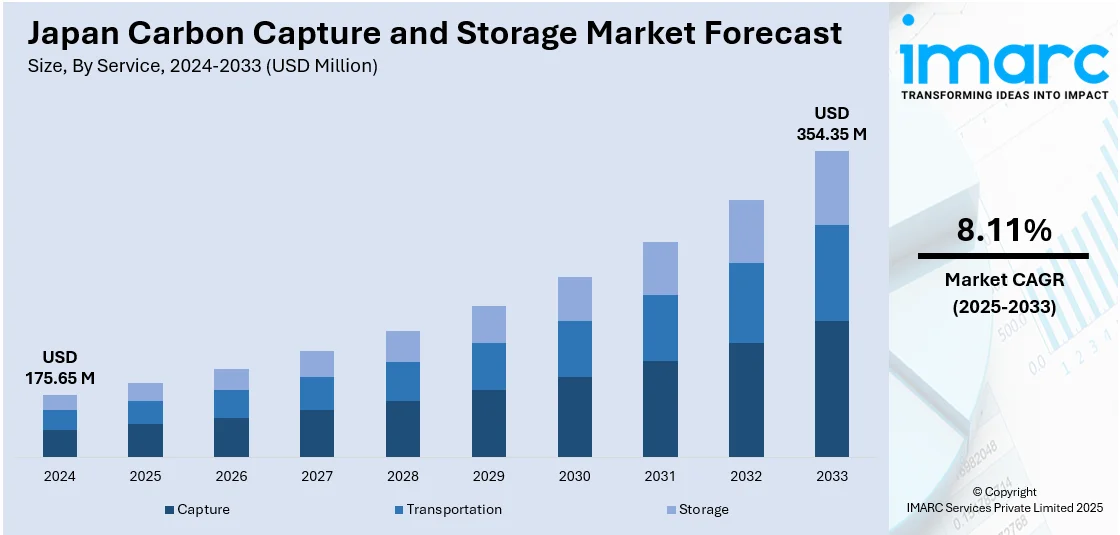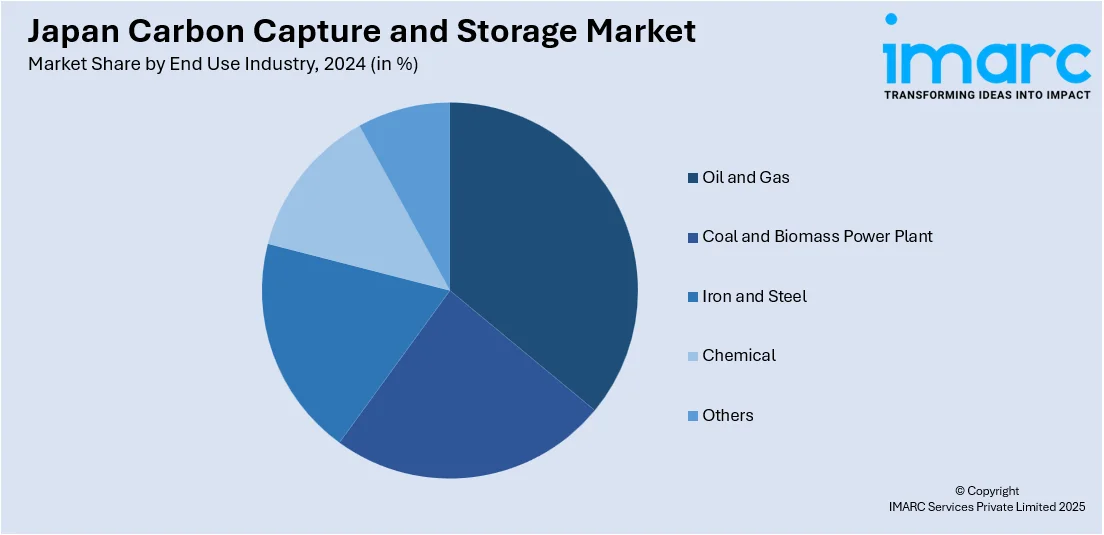
Japan Carbon Capture and Storage Market Size, Share, Trends and Forecast by Service, Technology, End Use Industry, and Region, 2025-2033
Japan Carbon Capture and Storage Market Overview:
The Japan carbon capture and storage market size reached USD 175.65 Million in 2024. Looking forward, IMARC Group expects the market to reach USD 354.35 Million by 2033, exhibiting a growth rate (CAGR) of 8.11% during 2025-2033. At present, the growing dependence on clean energy is encouraging industries and power producers to reduce their environmental impact while shifting towards more sustainable methods, creating the need for carbon capture and storage solutions. Besides this, increasing industry activities are contributing to the expansion of the Japan carbon capture and storage market share.
|
Report Attribute
|
Key Statistics
|
|---|---|
|
Base Year
|
2024
|
|
Forecast Years
|
2025-2033
|
|
Historical Years
|
2019-2024
|
| Market Size in 2024 | USD 175.65 Million |
| Market Forecast in 2033 | USD 354.35 Million |
| Market Growth Rate 2025-2033 | 8.11% |
Japan Carbon Capture and Storage Market Trends:
Increasing reliance on clean energy
The rising dependence on clean energy is positively influencing the market in Japan. As per industry reports, in the initial two months of 2024, clean energy sources accounted for 31.6% of Japan's electricity, an increase from 28% during the corresponding period in 2023. As Japan is investing in renewable sources like solar, wind, and geothermal energy, there remains a need to manage emissions from existing infrastructure reliant on fossil fuels. Carbon capture and storage technologies help bridge this gap by capturing carbon dioxide emissions from power stations, manufacturing plants, and various other sources before they enter the atmosphere. This process supports Japan’s climate goals and aligns with its commitment to achieve carbon neutrality. As clean energy is becoming more prominent, policymakers and energy companies are integrating carbon capture and storage solutions into energy planning and infrastructure development. These technologies allow the continued use of certain energy resources while minimizing environmental impact. Industries, such as chemical manufacturing, which are difficult to fully decarbonize, are also adopting carbon capture and storage systems to meet stricter environmental regulations. Government support, research initiatives, and international cooperation are further contributing to the growth of the market. The shift towards clean energy does not eliminate the need for emission control but instead creates a complementary demand for technologies like carbon capture and storage, making it a critical component of Japan’s evolving energy landscape.

Rising industrial activities
High industrial activities are impelling the Japan carbon capture and storage market growth. Japan’s strong presence in thriving sectors, such as manufacturing, steel production, chemical processing, and energy generation, leads to substantial greenhouse gas output. According to the IMARC Group, the Japan steel market size reached USD 84.3 Billion in 2024. To comply with environmental regulations and meet national climate targets, industries are employing carbon capture and storage technologies. These systems allow companies to capture emissions at the source and transport them for secure storage, reducing their environmental impact. As industrial operations are expanding, the requirement to minimize emissions is growing, making carbon capture and storage a strategic investment. The government is also supporting this shift by offering incentives and setting policies that encourage cleaner industrial practices. Energy-intensive industries view carbon capture and storage as a practical way to continue operations while aligning with sustainability goals. The combination of environmental responsibility and technological innovations ensures that increasing industrial activities continue to drive the demand for carbon capture and storage systems in Japan.
Japan Carbon Capture and Storage Market Segmentation:
IMARC Group provides an analysis of the key trends in each segment of the market, along with forecasts at the country and regional levels for 2025-2033. Our report has categorized the market based on service, technology, and end use industry.
Service Insights:
- Capture
- Transportation
- Storage
The report has provided a detailed breakup and analysis of the market based on the service. This includes capture, transportation, and storage.
Technology Insights:
- Post-combustion Capture
- Pre-combustion Capture
- Oxy-fuel Combustion Capture
A detailed breakup and analysis of the market based on the technology have also been provided in the report. This includes post-combustion capture, pre-combustion capture, and oxy-fuel combustion capture.
End Use Industry Insights:

- Oil and Gas
- Coal and Biomass Power Plant
- Iron and Steel
- Chemical
- Others
The report has provided a detailed breakup and analysis of the market based on the end use industry. This includes oil and gas, coal and biomass power plant, iron and steel, chemical, and others.
Regional Insights:
- Kanto Region
- Kansai/Kinki Region
- Central/ Chubu Region
- Kyushu-Okinawa Region
- Tohoku Region
- Chugoku Region
- Hokkaido Region
- Shikoku Region
The report has also provided a comprehensive analysis of all the major regional markets, which include Kanto Region, Kansai/Kinki Region, Central/Chubu Region, Kyushu-Okinawa Region, Tohoku Region, Chugoku Region, Hokkaido Region, and Shikoku Region.
Competitive Landscape:
The market research report has also provided a comprehensive analysis of the competitive landscape. Competitive analysis such as market structure, key player positioning, top winning strategies, competitive dashboard, and company evaluation quadrant has been covered in the report. Also, detailed profiles of all major companies have been provided.
Japan Carbon Capture and Storage Market News:
- In February 2025, Japan's Ministry of Economy, Trade and Industry identified its first ‘specified area for carbon capture and storage to promote its carbon neutrality objectives. This site, selected for its appropriateness, was located offshore from Tomakomai, a city found on the northern island of Hokkaido. The carbon capture and storage technology, which included the separation and underground storage of CO2 released by factories, was key to this effort.
- In July 2024, the Japan Energy and Metals National Corporation (JOGMEC) chose nine carbon capture and storage initiatives as ‘Advanced CCS Projects’ for the fiscal year 2024. The nine projects chosen this time were also intended to capture around 20 Million Tons of CO2 annually, with five projects set for storage in Japan and the other four designated for the Asia-Pacific region. JOGMEC invited applications for design tasks and more associated with advanced carbon capture and storage projects, which would incorporate design efforts for the complete carbon capture and storage value chain and assessments of storage capacity.
Japan Carbon Capture and Storage Market Report Coverage:
| Report Features | Details |
|---|---|
| Base Year of the Analysis | 2024 |
| Historical Period | 2019-2024 |
| Forecast Period | 2025-2033 |
| Units | Million USD |
| Scope of the Report |
Exploration of Historical Trends and Market Outlook, Industry Catalysts and Challenges, Segment-Wise Historical and Future Market Assessment:
|
| Services Covered | Capture, Transportation, Storage |
| Technologies Covered | Post-combustion Capture, Pre-combustion Capture, Oxy-fuel Combustion Capture |
| End Use Industries Covered | Oil and Gas, Coal and Biomass Power Plant, Iron and Steel, Chemical, Others |
| Regions Covered | Kanto Region, Kansai/Kinki Region, Central/Chubu Region, Kyushu-Okinawa Region, Tohoku Region, Chugoku Region, Hokkaido Region, Shikoku Region |
| Customization Scope | 10% Free Customization |
| Post-Sale Analyst Support | 10-12 Weeks |
| Delivery Format | PDF and Excel through Email (We can also provide the editable version of the report in PPT/Word format on special request) |
Key Questions Answered in This Report:
- How has the Japan carbon capture and storage market performed so far and how will it perform in the coming years?
- What is the breakup of the Japan carbon capture and storage market on the basis of service?
- What is the breakup of the Japan carbon capture and storage market on the basis of technology?
- What is the breakup of the Japan carbon capture and storage market on the basis of end use industry?
- What is the breakup of the Japan carbon capture and storage market on the basis of region?
- What are the various stages in the value chain of the Japan carbon capture and storage market?
- What are the key driving factors and challenges in the Japan carbon capture and storage?
- What is the structure of the Japan carbon capture and storage market and who are the key players?
- What is the degree of competition in the Japan carbon capture and storage market?
Key Benefits for Stakeholders:
- IMARC’s industry report offers a comprehensive quantitative analysis of various market segments, historical and current market trends, market forecasts, and dynamics of the Japan carbon capture and storage market from 2019-2033.
- The research report provides the latest information on the market drivers, challenges, and opportunities in the Japan carbon capture and storage market.
- Porter's five forces analysis assist stakeholders in assessing the impact of new entrants, competitive rivalry, supplier power, buyer power, and the threat of substitution. It helps stakeholders to analyze the level of competition within the Japan carbon capture and storage industry and its attractiveness.
- Competitive landscape allows stakeholders to understand their competitive environment and provides an insight into the current positions of key players in the market.
Need more help?
- Speak to our experienced analysts for insights on the current market scenarios.
- Include additional segments and countries to customize the report as per your requirement.
- Gain an unparalleled competitive advantage in your domain by understanding how to utilize the report and positively impacting your operations and revenue.
- For further assistance, please connect with our analysts.
 Request Customization
Request Customization
 Speak to an Analyst
Speak to an Analyst
 Request Brochure
Request Brochure
 Inquire Before Buying
Inquire Before Buying




.webp)




.webp)












